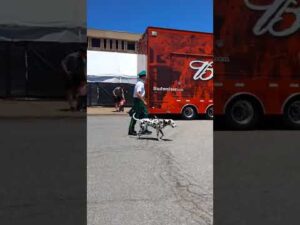
Spuds MacKenzie, the legendary bull terrier, became a cultural phenomenon in the late 1980s as the face of Bud Light beer. With his distinctive white coat and signature black patch over one eye, Spuds was more than just a mascot—he was a symbol of fun, good times, and party spirit. His rise to fame came through a highly successful advertising campaign by Anheuser-Busch, the brewing company behind Budweiser and Bud Light.
Debuting in 1987 during the Super Bowl XXI commercial, Spuds instantly captured the hearts of beer drinkers and pop culture enthusiasts alike. The commercial portrayed Spuds as the ultimate party animal, always surrounded by a group of lively young adults enjoying their Bud Light. His charisma and effortless coolness made him an overnight sensation, leading to a series of advertisements that further cemented his place in history.
The appeal of Spuds MacKenzie wasn’t just in his adorable looks—his character embodied an outgoing, carefree personality that resonated with audiences. His portrayal in commercials often featured him lounging poolside, attending wild parties, or being adored by enthusiastic fans. The clever marketing strategy behind Spuds helped Bud Light differentiate itself from competitors by associating the brand with fun and socializing.
However, Spuds’ popularity also came with controversy. Advocacy groups and politicians raised concerns about the dog’s influence on underage drinking, arguing that the lovable mascot appealed to children as much as it did to adults. Some critics pointed out that Spuds MacKenzie merchandise, which included T-shirts, plush toys, and posters, was being purchased by younger audiences. In response to these criticisms, Anheuser-Busch maintained that Spuds was never intended to target children but was instead a lighthearted branding tool for legal-age beer consumers.
Despite the backlash, Spuds MacKenzie remained a beloved figure in advertising for several years. His fame extended beyond commercials, appearing in talk shows, magazines, and even inspiring parodies. At the peak of his popularity, he became a pop culture icon, recognized by people who had never even tried Bud Light.
Ironically, Spuds MacKenzie was not actually male, as portrayed in the commercials, but was played by a female bull terrier named Honey Tree Evil Eye. This revelation added to the intrigue and legacy of the character, as fans learned more about the dog behind the legendary advertisements.
By 1989, Anheuser-Busch decided to retire Spuds MacKenzie, partially due to the controversy surrounding the character and a shift in marketing strategies. Although his reign as the Bud Light mascot was short-lived, his impact endured. Decades later, Spuds MacKenzie remains a nostalgic figure, remembered fondly by those who experienced the height of his fame.
In 2017, Bud Light revived Spuds MacKenzie for a Super Bowl commercial, presenting him in ghostly form to humorously deliver a message about friendship and good times. This revival proved that, even after decades, Spuds still held a special place in the hearts of many.
Though his time in the spotlight has long passed, Spuds MacKenzie’s legacy as the ultimate party dog lives on, forever a symbol of a bygone era of creative and memorable advertising.